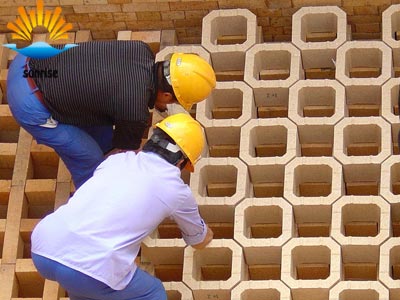The Construction Technology Program of Refractory Materials Ⅰ
2016-08-11
Ⅰ. General Provisions
The technical requirements applies to the construction technical requirements of refractories for most furnace and heat treatment furnace, including insulation materials, more reference given to the construction process.
When the technical requirements have discrepancies with drawings and data, the latter and the actual situation shall prevail.
Ⅱ. Pre-construction conditions
The construction work of refractory materials must be performed by a qualified professional company.
The construction of furnaces should be started only after the construction of furnace base, furnace steel and pipes and the installation of related equipment are almost finished, inspected and accepted and the procedure handover certificate is signed.
Before the construction, first review the centerline, elevation (in contrast to the reference point), the flatness of the shell, and all kinds of door openings, bottom column perforation, burner openings, pyrometer holes, manometer holes and camera holes. Pipes and flues requiring internal thermal insulation should be delivered and accepted.
The procedure handover certificate shall include the followings: a) the measurement recordings of the furnace centerline and control elevation, b) acceptance records of concealed works, c) pressure test records and welding tightness records of water cooling components and pipelines, d) repetition measurement records of the main dimensions of the installation locations of steel structures and furnace rails, e) the commissioning records of the hearth movable part and the furnace movable parts, f) inspection records of anchor location, size and quality of the welding, and g) furnace skin opening position.
The safety technology and labor protection of the industrial furnace construction should comply with the relevant provisions of the standard issued by the State.
Before the start of the construction, the plant should be capped, the roads be smooth, dangerous parts be fenced or covered and the 24-hour continuous supply of water, electricity and gas should be guaranteed. In special cases, notify in advance.
The construction company should have: a) the necessary templates, special templates, stencils, arch tire and scaffolding; b) all of the necessary equipment, such as various personal bricklaying tools (slurry tank, large shovel, rubber hammer, feeler, fountain, line board and plumb bob) and brick cutter; c) mixer and vibrator for the construction of castables; d) ramming pneumatic hammers for the construction of plastic materials; e) yellow cardboards for reserved expansion joints; f) water storage tank and necessary transport tools.
Necessary safety measures should be taken in the working surface. In the upper part of the work area, a solid platform should be installed for the movement of persons and temporary storage materials. Holes on the floor should be fenced or covered to avoid accidents.
Material stacking space and warehouses should be set at site. Material stacking space should be rainproof.
Check all drawings. Confirm that the construction drawings to be used are effective.
Ⅲ. Materials
1. The basic requirements for the materials
Materials at site must comply with drawings and specifications.
The name and logo of the materials at site must be clear. The packaging should be standard. All packaging materials should be equipped with rainproof devices. Monolithic refractories should have fixed packaging. Bulk refractories should not exceed 25kg/bag.
There must be factory certificates for refractory products transported to the site. Bulk refractories should have instructions for use which explains the use and the expiration date.
2. Acceptance, storage and transport
Verify the product certifications, manual instructions, labels, packaging and weight of refractory materials at site and whether they are damaged or damp during the transporting process. If there is any problem, contact the manufacturers or the purchasing department in time.
Check the quantity of shaped materials. If the conditions permit, check the weight of the bulk refractories. If not, weight the single bag and then count the number.
After the materials are transported into the factory, contact the company to confirm if there is the need for secondary re-examination.
Load and unload materials lightly. Avoid rough handling. When shaped refractory materials are loaded and unloaded with crane trucks, find lifting point. Do not use steel rope for lifting directly. If lifting is necessary, use bag rope and fix it on the stress face. Bulk materials should be stacked.
The surface of the transport tools should be smooth to avoid cutting the package during the secondary transportation.
Refractory materials in the warehouse should be placed in the order of grade, grade and number and marked.
During the process of transportation and storage, prevent the materials from being wetted. Refractory mortar, powder, aggregates, binders, ramming material, plastic materials, spray coatings, castables and refractory fibers must be kept separately in moisture-proof anti-fouling warehouses and should not be confused. Anti-freezing measure should be taken for refractories with anti-freezing requirements.
3. Refractory mortar
The refractoriness and chemical composition of refractory mortar should be adapted to the refractoriness and chemical composition of refractory products. The types, brand and other indicators of the mortar should be selected according to the temperature and operating conditions of the furnace.
Before the construction, the consistency and the amount of water should be determined by experiment according to the types of furnaces. Check if the construction properties (mainly refers to the bonding time) of mortar can meet the construction requirements.
The bonding time of mortar is up to the appearance and size of refractory products, generally 1-1.5mim.
The consistency of mortar should be adapted to the types of the masonry.
